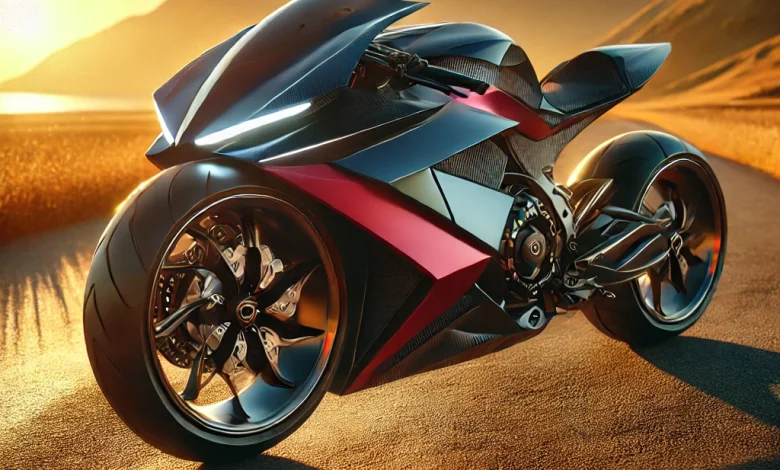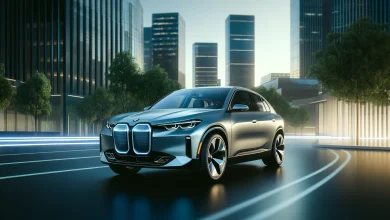Top 10 Best Sport Bikes in 2025: Powerful, Speedy, and Unmatched Performance!

Table of Contents
Sport bikes, also known as superbikes, are among the most thrilling and popular motorcycles on the market today. Known for their high performance, speed, and sleek design, sport bikes are the perfect choice for those seeking an adrenaline rush on two wheels. This article delves deep into the world of sport bikes, exploring their history, key features, performance capabilities, and the emotions they evoke in riders. Whether you’re a seasoned rider or someone considering purchasing a sport bike, this guide will provide you with all the essential information to understand and appreciate these incredible machines.
What Are Sport Bikes?
Sport bikes are a category of motorcycles designed specifically for high-performance riding. These bikes are engineered to excel in speed, agility, and precision, offering riders a thrilling combination of quick acceleration, exceptional handling, and high-speed capabilities. Whether you’re tearing up the streets or racing on a track, sport bikes are built to provide an adrenaline-packed experience.
Sport bikes are characterized by their lightweight construction, aggressive styling, and powerful engines. They are designed to be highly responsive, offering precise control in both straight-line and cornering performance. These bikes are ideal for riders who enjoy pushing the limits, whether for casual road riding or competitive motorsport events.
The sport bike category includes various models, from entry-level machines designed to help new riders learn the ropes, to high-performance models built for professional racers. Regardless of their level, all sport bikes share a common focus on performance and agility, making them the ultimate choice for thrill-seekers.
Key Features
Sport bikes are engineered with several key features that set them apart from other types of motorcycles. These features focus on maximizing performance and handling, allowing the rider to enjoy a smooth, fast, and controlled experience on the road or track.
1. Engine
The engine is one of the most important components of a sport bike, and it plays a significant role in determining the bike’s power and performance. Most sport bikes are equipped with inline-four engines, which provide smooth power delivery and high-revving capabilities. These engines are known for their ability to reach high RPMs, delivering quick acceleration and impressive top speeds.
While inline-four engines are the most common, some sport bikes come with V-twin or parallel-twin engines. These alternative configurations offer different power characteristics, such as a stronger mid-range torque for better street performance or a more balanced power curve for track use.
Sport bike engines are typically liquid-cooled to maintain optimal performance even during high-speed runs. They are designed to be lightweight yet powerful, allowing the bike to accelerate rapidly and maintain high speeds with ease.
2. Suspension
The suspension system is essential to a sport bike’s handling, providing the necessary control during aggressive cornering and high-speed maneuvers. Sport bikes feature advanced suspension systems that help the bike stay stable and responsive.
The front suspension usually consists of telescopic forks, which are designed to absorb shocks from the road, ensuring the bike stays steady during sharp turns and bumps. These forks are often adjustable, allowing riders to fine-tune the suspension based on their weight, riding style, and the road conditions they are encountering.
The rear suspension is typically an adjustable monoshock system, which offers precise control of the rear wheel, improving traction and stability. Riders can adjust the monoshock for different riding conditions, whether they’re on a track or navigating a winding mountain road. The ability to adjust both the front and rear suspension ensures a smooth ride and improved handling at all speeds.
3. Braking
Braking performance is crucial for sport bikes, as riders often need to stop quickly and safely, especially at high speeds. Sport bikes are equipped with powerful disc brakes, usually featuring dual front disc brakes and a single rear disc brake. These systems deliver strong stopping power, allowing the rider to make precise braking adjustments during high-speed riding or cornering.
Many modern sport bikes also come with ABS (Anti-lock Braking System), which prevents the wheels from locking up during emergency braking. This added safety feature helps maintain control during sudden stops or in slippery conditions, enhancing rider confidence.
The advanced braking systems on sport bikes enable riders to safely navigate sharp turns, maintain control at high speeds, and achieve optimal stopping performance in various riding conditions.
4. Riding Position
One of the defining characteristics of sport bikes is their aggressive riding position, which is designed to improve aerodynamics and handling. In contrast to the more relaxed positions found on cruiser or touring motorcycles, sport bikes have a forward-leaning posture with the rider’s knees tucked toward the tank and arms extended forward.
This riding position helps to reduce wind resistance, making it easier for the rider to maintain high speeds without feeling fatigued. The lower body position also improves control, particularly when leaning into corners, allowing the rider to feel more connected to the bike.
The foot pegs on sport bikes are often positioned higher and further back than on other motorcycles, further enhancing control during aggressive cornering. While the riding position may take some getting used to for new riders, it becomes second nature once the rider gains experience.
Evolution
The history of sport bikes dates back to the mid-20th century when motorcycles began to evolve from simple machines into highly specialized performance vehicles. Early models were built with minimal technological advancements, relying on manual skill and raw power to achieve high speeds.
The Birth of the Sport Bike
The 1960s and 1970s saw the introduction of models such as the Honda CB750, which is often considered the first true sport bike due to its revolutionary four-cylinder engine. During this time, manufacturers like Yamaha, Kawasaki, and Suzuki began to introduce their own sport bike models, each contributing to the development of modern superbikes.
Technological Advancements
By the 1980s and 1990s, sport bikes saw major technological advancements, including improved suspension systems, lightweight materials, and aerodynamic fairings. This era also saw the rise of superbike racing, which pushed manufacturers to innovate in terms of both performance and design.
In the 21st century, sport bikes have continued to evolve with the introduction of electronic fuel injection (EFI), advanced traction control systems, and superior braking technologies. Today, sport bikes are known for their cutting-edge features, which continue to push the boundaries of performance and design.
Key Components
To truly appreciate the power, precision, and engineering behind a sport bike, it’s essential to understand the key components that contribute to its exceptional performance. These elements work in harmony to provide the speed, handling, and control that define the sport bike experience.
1. Engine
The engine is the heart of any sport bike, and it plays a crucial role in delivering the power and acceleration that make these machines thrilling to ride. Most sport bikes feature four-stroke, liquid-cooled engines designed to perform at high revs, offering quick throttle response and the capability to reach incredible speeds. Engine displacement typically ranges from 300cc to well over 1000cc, with larger engines providing more power for aggressive acceleration and higher top speeds.
The engine configuration can vary depending on the bike, with the most common setups being:
- Inline-four engines: Known for their high-revving capabilities, these engines are used in many top-tier sport bikes, delivering smooth power and exceptional performance at high RPMs.
- V-twin engines: Found in many middleweight and high-performance models, V-twins provide a distinctive torque curve, offering smooth and reliable power delivery at lower RPMs.
- Parallel-twin engines: Often seen in entry-level or mid-range sport bikes, parallel-twin engines provide a balanced power-to-weight ratio, offering a responsive ride with adequate power for street and track use.
Sport bike engines are designed to produce incredible power outputs while maintaining efficiency and reliability, contributing to the overall excitement and versatility of these motorcycles.
2. Suspension and Handling Systems
The suspension system of a sport bike is vital for ensuring stability, comfort, and control, especially when cornering at high speeds or riding on uneven surfaces. A well-tuned suspension system enhances the bike’s performance, enabling it to handle aggressive turns, rough terrain, and even track conditions with ease.
- Front suspension: Sport bikes typically feature telescopic forks, which are designed to absorb shocks and maintain the bike’s stability while allowing the rider to make precise adjustments for varying road conditions. These forks provide a smooth ride and improve handling, ensuring that the bike stays stable during aggressive cornering and quick maneuvers.
- Rear suspension: The rear of the bike usually employs an adjustable monoshock setup, which allows riders to fine-tune the ride quality based on their preferences and the conditions of the road or track. This monoshock system improves the bike’s stability by keeping the rear wheel in contact with the road at all times, enhancing grip and overall control.
The ability to adjust the suspension based on personal preference or specific riding conditions is one of the reasons why sport bikes excel in precision handling, providing riders with a more connected experience to the road.
3. Tires and Braking Systems
Sport bikes are equipped with high-performance tires designed to deliver superior grip, handling, and stability, especially during aggressive cornering and braking. The tires are typically made from soft rubber compounds, which provide excellent traction on both wet and dry surfaces. These tires are optimized for performance, offering maximum grip to ensure that the rider can lean into corners without losing traction.
- Tires: Sport bike tires come in various designs, often with a dual-compound structure that combines durability in the center with softer rubber on the edges for better grip during turns. These tires are essential for ensuring that the bike maintains control at high speeds and under extreme lean angles during cornering.
- Braking system: The braking system on sport bikes is highly advanced to provide quick and reliable stopping power. Sport bikes typically feature dual front disc brakes and a single rear disc brake, which work together to ensure efficient deceleration. These systems are often paired with ABS (Anti-lock Braking System), which prevents the wheels from locking up during emergency braking, improving safety and control.
The ability to stop quickly and safely is just as important as acceleration in ensuring a sport bike’s overall performance. The braking and tire systems are engineered to work seamlessly, giving riders the confidence to push their limits without sacrificing safety.
4. Aerodynamics and Design Features
One of the key aspects of any sport bike is its aerodynamic design. The bodywork, fairings, and overall shape of the bike are all carefully crafted to reduce drag, allowing the bike to slice through the air with minimal resistance. This aerodynamic design is crucial for maintaining high speeds and stability, especially during fast straightaways and cornering.
The riding position is another important design feature. Sport bikes typically have a more aggressive riding stance, with the rider leaning forward with their arms extended. This position not only enhances aerodynamics by reducing the rider’s wind resistance but also helps the rider maintain control of the bike, particularly when navigating corners at high speeds.
- Fairings and bodywork: The streamlined fairings on sport bikes are designed to provide optimal airflow, cooling the engine and reducing drag. These components help the bike stay stable at high speeds and prevent overheating during extended rides or races.
- Seat and footpeg positioning: The rider’s seating and footpeg positions are also optimized for control and comfort. The footpegs are usually set higher and further back to allow for more aggressive cornering and control, while the seat is designed to be both supportive and comfortable during fast rides.
Aerodynamics and rider positioning play a critical role in a sport bike’s overall performance. By reducing drag and improving control, these features allow riders to maintain higher speeds and better stability, especially when pushing the limits on tracks or during spirited rides on winding roads.
Performance and Speed
One of the main attractions of sport bikes is their exceptional performance. These motorcycles are built to deliver unmatched acceleration, top-end speed, and cornering capabilities. The powerful engines in sport bikes allow them to accelerate from 0 to 60 mph in a matter of seconds, with some of the most powerful models reaching top speeds in excess of 200 mph.
Lightweight Construction for Enhanced Performance
The lightweight construction of sport bikes further enhances their performance. A lower overall weight helps the bike achieve better handling, quicker acceleration, and increased maneuverability. The design of sport bikes ensures that they offer an ideal balance between speed, stability, and agility, making them perfect for both open-road riding and track racing.
The Thrill of Riding
Riding a sport bike is an experience like no other. The combination of speed, control, and adrenaline creates a unique bond between the rider and their machine. When you’re on a sport bike, you’re not just riding—you’re feeling the power and performance in every twist of the throttle and lean through every turn.
Adrenaline Rush and Emotional Appeal
The aggressive riding position and responsive controls allow riders to fully engage with the road, offering an unmatched sense of connection to the bike. Whether it’s carving through mountain roads or reaching high speeds on the highway, sport bikes provide a thrilling, heart-racing experience that few other types of motorcycles can match.
Additionally, the sound of the engine as it roars through the gears and the rush of wind against your body only add to the sense of exhilaration. For many riders, owning and riding a sport bike is about more than just performance—it’s about feeling the rush of adrenaline and the freedom of the open road.
Popular Bike Models
Over the years, several sport bike models have earned legendary status among riders due to their performance, design, and handling capabilities. These motorcycles have captured the hearts of enthusiasts around the world and continue to set benchmarks for excellence in the sport bike category. Let’s take a closer look at some of the most popular models that have become iconic in the motorcycling community.
1. Yamaha YZF-R1
The Yamaha YZF-R1 is often regarded as one of the most iconic and successful sport bikes in history. With a design inspired by Yamaha’s MotoGP machines, the R1 has a reputation for blending aggressive styling with incredible performance. This sport bike features a high-revving inline-four engine, delivering impressive acceleration and top-end power. The Yamaha R1 is known for its precision handling, making it ideal for both the streets and racetracks.
Incorporating cutting-edge technology, the Yamaha YZF-R1 is equipped with advanced electronics, including traction control, quick-shift systems, and ride modes to adapt to different riding conditions. The bike’s lightweight design ensures exceptional maneuverability, while the aerodynamic frame optimizes stability at high speeds. Riders looking for a machine that offers a perfect balance between power, speed, and track-worthy performance often choose the R1.
2. Kawasaki Ninja ZX-10R
The Kawasaki Ninja ZX-10R is another top-tier bike that stands out for its extreme performance and aggressive design. A favorite on both the racetrack and open roads, the ZX-10R comes equipped with a 998cc inline-four engine that produces exhilarating power, enabling the bike to excel in both acceleration and high-speed handling.
What sets the Kawasaki Ninja ZX-10R apart is its advanced suspension system, which features Showa Balance Free Forks for better ride feel and improved handling during cornering. The Ninja ZX-10R also comes with Kawasaki’s Cornering Management Function and KTRC (Kawasaki Traction Control), which ensures optimal control even under challenging road conditions. Whether you’re on a fast-paced track or winding backroads, the ZX-10R offers top-notch stability and responsiveness.
For those seeking a sport bike with unrivaled power and state-of-the-art technology, the Ninja ZX-10R has remained one of the most competitive and popular choices in the sport bike world.
3. Suzuki GSX-R1000
The Suzuki GSX-R1000 has been a mainstay in the world of high-performance motorcycles for years. Known for its blend of raw power and superb handling, the GSX-R1000 is one of the most popular superbikes, offering excellent performance on both the track and the street. Its 1000cc engine is finely tuned to produce exceptional speed and acceleration, while its lightweight frame and rigid chassis contribute to its remarkable agility.
The Suzuki GSX-R1000 features Suzuki’s Advanced Traction Control System, which helps maintain control under high-performance riding conditions. Additionally, the suspension system is carefully designed to ensure stability during fast cornering and long rides. The GSX-R1000’s aerodynamic fairing reduces drag, enhancing its high-speed stability and providing a more comfortable ride, especially during aggressive riding.
Riders looking for a sport bike that delivers outstanding performance, whether on a racetrack or urban roads, often choose the GSX-R1000 for its precise handling and powerful engine.
4. Honda CBR600RR
The Honda CBR600RR is a versatile and well-balanced bike that offers a perfect combination of power, comfort, and handling. Known for its smooth ride and nimble handling, the CBR600RR is often considered an excellent choice for riders who enjoy a mix of street riding and occasional track days. With its 599cc inline-four engine, the bike delivers ample power for everyday riding while maintaining a manageable performance level for riders of various skill levels.
One of the standout features of the Honda CBR600RR is its lightweight design, paired with an adjustable suspension system that enhances the rider’s experience, whether on twisty backroads or at the racetrack. The Honda CBR600RR also comes equipped with dual-stage fuel injection, improving throttle response and fuel efficiency. Its compact design and ergonomic riding position make it comfortable for longer rides, making the CBR600RR a great choice for riders who want a bike that balances performance with comfort.
Whether you’re a seasoned track rider or someone looking for a reliable and responsive street bike, the Honda CBR600RR offers a great option for enthusiasts looking for a bike that delivers high-performance capabilities with everyday practicality.
Safety Considerations
While sport bikes offer an unparalleled riding experience, they also come with inherent risks. The high speeds and aggressive riding positions can be dangerous if not approached with caution and proper training.
Safety Gear
Wearing the proper safety gear is essential when riding a sport bike. Helmets, gloves, jackets, pants, and boots made from high-quality materials like leather or textile can help protect the rider in the event of an accident. Armor and padding in these garments can also reduce the impact of a crash.
Riding Tips for Safety
To ensure a safe riding experience, it’s crucial to:
- Always wear a helmet.
- Ride within your limits and experience level.
- Practice defensive riding techniques, especially in heavy traffic.
- Maintain your bike regularly, ensuring the tires, brakes, and suspension are in top condition.
Bikes in Popular Culture
Sport bikes have made their mark in popular culture, appearing in countless movies, TV shows, and advertisements. Films like The Fast and the Furious franchise and Mission: Impossible feature sport bikes in high-octane chase scenes, further cementing their status as symbols of speed and freedom.
Motorcycling Lifestyle and Influence
Moreover, sport bikes have become a part of youth culture, with many riders seeing them as symbols of rebellion, performance, and a carefree lifestyle. Motorcycling events, motorcycle clubs, and track racing further contribute to the growing influence of sport bikes in modern society.
Conclusion
Sport bikes are more than just powerful machines—they represent the pinnacle of motorcycle engineering, where performance, design, and rider experience seamlessly come together. These high-performance motorcycles offer unmatched agility, speed, and precision, making them the top choice for enthusiasts who crave an adrenaline-filled ride. Whether you’re pushing the limits on the open road or tackling challenging racetracks, a sport bike provides an exhilarating experience that few other vehicles can match.
The advanced technology incorporated into modern sport bikes continues to redefine what’s possible in the world of motorcycling. Features like state-of-the-art suspension systems, electronic riding aids (such as traction control and anti-lock braking systems), and lightweight yet durable frames ensure that sport bikes deliver not only thrilling speed but also top-tier safety and handling. This makes them a versatile choice for both beginners and experienced riders, catering to a wide range of skill levels and riding preferences.
Sport bikes aren’t just about high speeds—they also embody a strong sense of passion and lifestyle. The unique riding position, the roar of the engine, and the wind rushing past you create a connection between rider and machine that is hard to replicate with any other type of motorcycle. For many, owning a sport bike is not just about transportation—it’s about joining a community of like-minded riders who share a love for performance and adventure.
As technology continues to evolve, so too will the capabilities of sport bikes. Future models are expected to incorporate even more advanced features, including electric-powered sport bikes, which promise incredible torque and eco-friendly performance. The continued integration of AI, smart technology, and advanced materials will likely push the boundaries of speed, comfort, and safety, ensuring that sport bikes remain at the forefront of motorcycle innovation.
For those who seek the thrill of the open road and the excitement of the ride, sport bikes will always hold a special place in the world of motorcycling. With their unmatched combination of power, performance, and pure riding pleasure, sport bikes are here to stay, continuously offering new experiences for generations to come. Whether you’re an experienced rider or a newcomer, a sport bike provides an unforgettable journey that combines the best of speed, design, and freedom.
FAQs
1. What is a sport bike?
A sport bike is a type of motorcycle designed for high-speed performance, precision handling, and aggressive riding. These motorcycles are typically lighter and more aerodynamic than other types, allowing for greater agility and faster cornering. They come equipped with advanced suspension systems, powerful engines, and a design optimized for speed, making them a favorite among racing enthusiasts and adrenaline seekers.
2. How fast can a bike go?
The speed of these bikes can vary depending on the engine size and model. High-performance motorcycles can achieve speeds upwards of 200 mph, with the top-tier models like the Yamaha YZF-R1 and Kawasaki Ninja ZX-10R leading the pack in terms of raw power and speed. For beginners or those looking for more manageable speeds, models with smaller engines typically top out between 120 and 140 mph.
3. What is the difference between a sport bike and a cruiser?
While both sport bikes and cruisers are types of motorcycles, their design and intended use differ greatly. Sport bikes are optimized for agility, speed, and performance, featuring a lightweight frame and a more aggressive riding position. They excel on winding roads, racetracks, and other high-speed environments. Cruisers, on the other hand, are designed for comfort, offering a more relaxed ride with a heavier frame and a lower riding position. They are better suited for long-distance cruising on highways rather than high-speed maneuvers.
4. What is the best motorcycle for beginners?
For those just starting in the world of motorcycling, it’s important to choose a bike that is both manageable and easy to handle. Many manufacturers offer models in the 300cc to 600cc range, which provide the perfect balance of power and control. Some great beginner-friendly motorcycles include the Kawasaki Ninja 400, Yamaha YZF-R3, and Honda CBR500R. These models are known for their forgiving nature, helping new riders develop their skills without overwhelming them with excessive power.
5. How much does a sport bike cost?
The price of a sport bike can vary significantly based on its features, engine size, and brand. Entry-level models typically cost between $4,000 to $7,000, while high-end superbikes can reach prices of $10,000 to $20,000 or more. For example, the Kawasaki Ninja ZX-10R and Yamaha YZF-R1 are premium models that are priced higher due to their advanced technology and superior performance capabilities.
6. Are sport bikes dangerous?
Like all high-performance vehicles, sport bikes carry certain risks, particularly due to their high speed and the aggressive riding posture required to handle them. Riders should be aware of their surroundings, practice defensive riding, and take safety precautions. Wearing the proper safety gear, such as helmets, gloves, jackets, and boots, is crucial. Additionally, taking a motorcycle safety course and gradually gaining experience will help reduce the risk of accidents.
7. What safety gear is recommended for riding a sport bike?
Proper safety gear is essential for anyone riding a sport bike to reduce the risk of injury. The most important items include:
- Full-face helmet: Protects the head in the event of an accident.
- Armored jacket: Provides protection for the upper body with built-in padding for key areas.
- Gloves: Help protect your hands from injury and provide better grip.
- Riding pants: Made from durable materials with protective armor for the knees and hips.
- Motorcycle boots: Protect the feet and ankles from impacts.
8. Can I ride a sport bike on the street and the track?
Yes, most sport bikes are versatile enough for both street and track use. However, if you plan to use your sport bike on a racetrack, you may want to consider certain modifications. Track modifications might include adding racing tires, adjusting the suspension, and removing or altering certain features that are more suited for street riding, like turn signals and headlights. Many sport bikes are designed to perform well in both environments, but track riders often prioritize modifications for maximum performance.
9. How do I maintain a sport bike?
Regular maintenance is key to keeping your sport bike running smoothly and ensuring its longevity. Here are some essential maintenance tips:
- Oil changes: Regularly changing the oil is vital for engine health, typically every 3,000 to 5,000 miles.
- Tire checks: Ensure that the tires have sufficient tread and are properly inflated to maintain traction.
- Brake inspections: Check for wear on the brake pads and replace them when necessary to ensure safe stopping power.
- Chain maintenance: Clean and lubricate the chain regularly to prevent it from wearing out prematurely.
- Suspension upkeep: If the suspension feels off or has been in use for a long period, get it professionally serviced.
10. What is the lifespan of a sport bike?
The lifespan of a sport bike depends largely on its maintenance and how it’s used. With proper care, a sport bike can last anywhere between 30,000 to 50,000 miles. However, models designed for racing or aggressive riding may have a shorter lifespan due to the higher demands placed on the engine and components. Regular servicing and maintenance can help extend the bike’s life, making it a lasting investment.
11. What are the most popular sport bike brands?
Several motorcycle manufacturers are known for producing high-quality sport bikes with cutting-edge technology and superior performance. Some of the most popular brands in this category include:
- Yamaha (known for models like the YZF-R1 and YZF-R6)
- Kawasaki (with models like the Ninja ZX-10R and Ninja ZX-6R)
- Honda (notable models include the CBR1000RR and CBR600RR)
- Suzuki (offering models like the GSX-R1000 and GSX-R750)
- BMW (known for the S1000RR)
- Ducati (with high-performance models like the Panigale V4)
These manufacturers have built a reputation for delivering superbikes that combine innovation, speed, and reliability.




